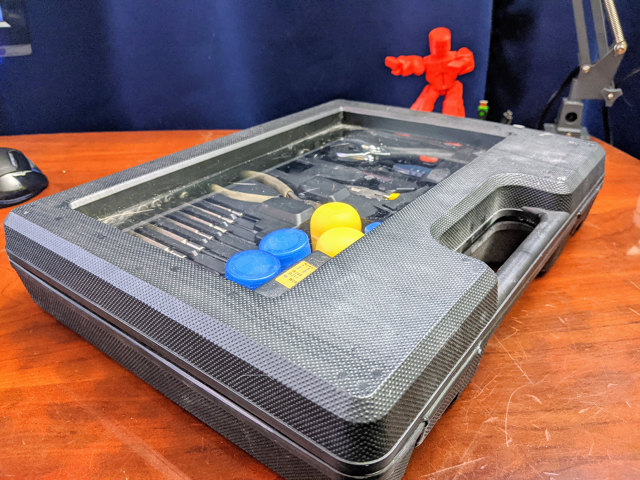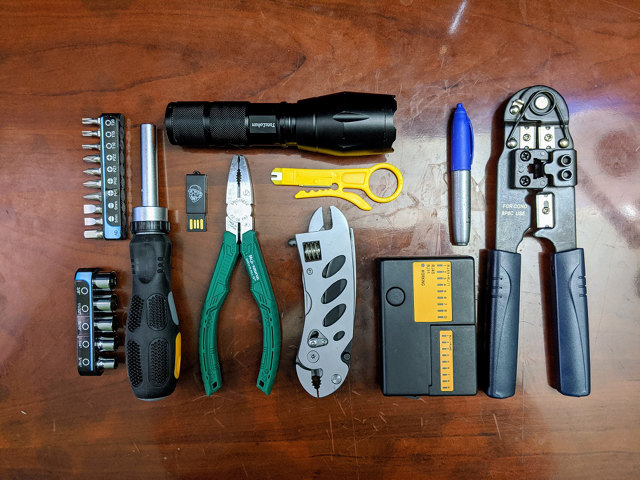Designing a Network Engineer's Toolkit
I don’t know that this is still a good name for what I’m designing. When I worked for a giant insurance company, everyone had the word “analyst” in their job title. At all the telecom companies I worked for, everyone with a technical job was an engineer. My father worked on the railroad, but he was a totally different kind of engineer.
When I was a network engineer, I wasn’t really a network engineer. I mostly worked with servers. Sure, there was some physical work with the machines involved in this, but most of my job involved sitting at a desk, looking at a screen, and using a keyboard and mouse to do my work.

I did touch hardware often enough, so I used to keep lots of handy things in my laptop bag: a punch-down tool, screwdrivers, CDs full of software, USB drives, wire cutters, and an RJ-45 crimper. There were other tools I might have been carrying, and I definitely didn’t always carry each of these tools all the time.
Why do I still pack my laptop bag like I might have to use this stuff?
I think I may have stepped foot in a data center twice in the last ten years. I rarely touch anyone’s computer hardware except my own. Until a few years ago, I still used to make sure I had room for all this gear in my laptop backpack.
If you keep this stuff packed, you have to make sure you go through it before traveling, because you don’t want the TSA to confiscate any of it.
I took a photo of the tool, manually traced it with @tedjgould's Inkscape, added a 2mm margin in CAM, and this is the result. The 2mm was probably too much, but I think I'm on the right track here! pic.twitter.com/B99DcFcEKc
— Pat Regan (@patsheadcom) September 1, 2020
I wound up taking most of the tools out of my bag, and someone bought me a toolkit from Amazon. I found a similar toolkit on Amazon. Mine did not include the RJ-45 tester, but everything else looks the same. It has a lot of tools I’d never use, and it was missing several important tools that I had to add.
The toolkit from Amazon is a rectangle about the size of a rather thick 15” laptop. It is easy to put it into my bag when I know I’ll need tools, and it is easy to take the whole thing out when I travel. That part is awesome, but I want to do this better.
- Network Toolkit with RJ-45 Crimpers at Amazon
The problems with the toolkit from Amazon
The most obvious problem is how much space it wastes. Nearly half of the space is taken up by the lid, and there is absolutely nowhere to store anything in that space. That’s a huge waste!
It also has tools that I’d never need. There’s a cheap set of six precision screwdrivers. My cheap precision driver and bit set from Harbor Freight takes up about as much space, and it has 30 bits and a set of tweezers. This part of the kit could definitely be improved.
It has a set of wire snippers and a set of needle-nose pliers. Do I really need both of these? If I take one out, I can’t really fit anything in that awkward space, either.
The RJ-45 crimping tool this kit came with is fine. The flashlight is worthless.
I added a cheap RJ-45 continuity tester thing and some small containers of screws.
Most importantly, though, I added a crescent wrench. An adjustable wrench is so much nicer than pliers, and you wouldn’t believe how many chairs and tables I’ve tightened up in my travels! You should always have one of these in your bag.
So what the heck am I planning to do?
I was thinking about this before I even placed the order for my Shapeoko XXL. I knew I needed to use the CNC to cut a nice wooden tool case to replace this network engineer toolkit.
I’m sticking with the rectangle, but I plan to round the corners. I might aim to be closer to the dimensions of a 13” laptop instead of a 15” laptop. It will definitely be thinner. I don’t think I’m going to carve any tool storage into the lid.
I’m trying to decide how modular the interior should be. So far, I want the important tools to have permanent, dedicated homes. Maybe I’ll leave room to Velcro in 3D-printed tool holders for future upgrades and changes.
Which tools should go in this toolkit?
When I design something like this, I prefer to design it around tools that are readily available. The CNC machine is fun, because I can design indentations that perfectly fit that oddball RJ-45 continuity tester that I bought for $8 in 2006. Everything I make can be completely customized, right?!
I need to start working with wood. The Shapeoko just plows through this stuff like butter! pic.twitter.com/vF2yNFejNd
— Pat Regan (@patsheadcom) September 1, 2020
This should be an open source toolkit. If I put in a custom slot to perfectly fit a tool that no one can acquire in 2020, it is useful only to me! This may be a bad example, because Banggood sure seems to have a nearly identical tester in stock, but you get the idea. My tester is not nearly as fancy as Brian’s Pockethernet, but it does a good job of letting me know if I goofed up the wiring order on my cable.
A crescent wrench goes in here for sure. I’ll want RJ-45 crimpers, a punch-down tool, and a nice driver with appropriate bits.
I need your help figuring out what to put in here!
Should I put a simple crescent wrench in the toolkit, or should I use a multitool with an adjustable wrench built in? Single-purpose tools are nicer to use, but using a multitool like this would fit a wrench, knife, and pliers into the same space.
Should I bother including a flashlight? We all have a light on our phones. Do we really need another?
Why crimpers? Is anyone besides me ever going to need crimpers? Maybe the crimpers and punch down tool should go in a swappable module!
There’s a much more important question that I need your help with. Which tools am I forgetting about?!
A quick mockup using tools that I have on hand
Nope. I’m not trying to practice my flat-lay photography skills. Peter McKinnon would almost certain tell me I’m doing a bad job with a layout like this!

I pulled the most useful tools from the network toolkit. I added a real flashlight, nice pliers, my Piranha multitool, a mini Sharpie marker, and a USB flash drive. I can already tell that this project is going to flex my Tetris skills.
I’m trying to reduce the thickness of my toolkit. Eliminating the wasted space in the lid will immediately free up a lot of space, but I’m noticing that the flashlight and cheap bit driver are quite thick. I will have to find better replacements for both of these. I may skip the flashlight.
UPDATE: Tool suggestions from the community!
As soon as I tweeted this, I started getting suggestions. I did ask what I should include in my toolkit, but I also expanded the question. I asked what tools you carry in your laptop bag that you don’t use often, but when you do use them, you’re glad you have them.
I was going to break this list of suggestions down by listing who submitted each suggestion. I’m not sure everyone wants to be immortalized in a blog post, so I’m going to leave the names out. If you want me to give you credit, I would be more than happy to do so!
- The WLAN Pi
- The Iodd Virtual CD-ROM SSD
- RJ-45 and RJ-14 couplers
- A battery-powered NAS plug
- Lockpicks!
- Rubber Ducky
- hackRF One
- Ubertooth One
- Pineapple
- LAN Turtle
- GL.iNet FL-AR750 Travel Router
- Analog Discovery 2 Oscilloscope
- Cheaper Seeed DSO Nano Oscilloscope
- a pocket microscope
- a Ganzo multitool
RJ-45 couplers are smart. I used to carry a couple of couplers and some custom 3” cables to turn any random patch cable into a crossover or rollover cable. I stopped carrying these, because I doubt I will ever need a rollover cable again, and most Ethernet ports today don’t even require a crossover cable.
Lockpicks just sound like fun. I have a couple sets, but I’ve never become proficient at using them.
The battery-powered NAS plug is interesting to me. I have an old RAVPower RP-WD03 FileHub Plus. We always referred to it as the “WiFi Dingus.” It is a battery-powered router. It has one Ethernet port for the WAN, a USB port, and an SD card slot. If you’re at a location with no WiFi, you can just plug this into an available LAN port and you’re ready to go. It used to come in handy a lot. I wonder if there’s a modern equivalent?
Enough of the suggestions so far are making me think I just need to carry a Raspberry Pi along with a handful of relevant microSD cards!
What’s next?
I’ll probably mess around with some scrap material. Do I want the interior of the toolkit to be wood, or should I cover it in fancy red velvet? Should I fit some sort of 3D-printed TPU grabbers to keep the tools in place, or should I rely on the fit of each tool slot to hold everything down? There will be a good amount of experimenting here!
That’s why I’m posting this before I get started. I need to find all the right tools to put in this kit, and I need your help to do it!
Am I missing an important tool? Should I swap one of my existing tools for something better? Am I doing this wrong, or am I on the right track? Let me know in the comments, or stop by the Butter, What?! Discord server to chat with me about it!